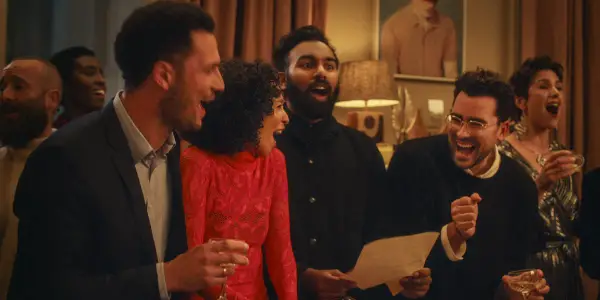
The idea of grief and pain go hand in hand when speaking of a great loss. When we all find ourselves experiencing the unavoidable void, what we don’t expect to find is the chance for healing and discovery. For Dan Levy‘s Good Grief, audiences come to cathartically experience both avoidance and acceptance of the pain felt in the aftermath of a great loss. But it is not just the pain Levy‘s Marc carries in the wake of his husband’s death, but the pain many carry in their daily lives. While Good Grief may run a bit long, its cathartic experience leaves audiences with hope rather than grief.
Cathartic Experience
Levy effectively creates the contrast between happiness and loss early on, the film opening on Christmas Eve as Marc and his husband Oliver (Luke Evans) welcome both family and friends into their yearly celebration. As Oliver leads the group in song and we are given intimate moments of camaraderie between friends, the tightly knit bonds feel cozy and welcoming. There is an effervescence in Oliver especially, the calm and content relationship between him and Marc apparent. Set to the backdrop of Christmas, each of these moments of interaction is wrapped in the warmth of an orange glow, the joy and brightness of the season making the impending tragedy all the more tragic.
source: Netflix
Following the morning after Oliver’s death, the color is leached from the picture, a grayish blue palette heightening the grief as Marc experiences the memories shared, muscle memory betraying him with each passing moment. It is an effective opening, pensively embracing the grief of Marc before working its way through the rest of the year. With the help of his friends Sophie (Ruth Negga) and Thomas (Himesh Patel), Marc works to heal in a year of loss, audiences become witnesses as he navigates and avoids the pain in a push and pull motion within the inertia of grief.
Yet, while the film primarily focuses on Marc, it is savvy to capture grief and pain not only through his eyes. While not as immediately apparent, the cool exteriors of Sophie and Thomas begin to shed their layers, giving audiences a breadth of pain – and a need to heal.
Levy is never in a rush to move his film forward. Even in the moments that feel drawn out a bit too long, there is an appreciation to the deeper breadth he gives the film. This is not a subject matter that can be quickly digested and moved along from, Levy giving audiences the time to feel each emotion, to alter their perceptions and feel the unstoppable force of the human experience. In these moments, audiences will come to see the film beyond its depiction of grief and pain, coming to understand that it is not just a love lost, but the love of those that remains.
source: Netflix
While the messaging and ramifications of the film ring long after the credits have rolled, this is a film bolstered by the performing trifecta of Dan Levy, Ruth Negga and Himesh Patel. Each brings their own sense of individuality and character understanding that provides both depth and authenticity to each character. Yet, they are able to craft a close kinship that speaks to years of unity in both the good and the bad moments they share. Their chemistry radiates, elevating the film beyond its subject matter and delivering the cathartic experience that will resonate with audiences.
Conclusion
Dan Levy works with grace, even in the devastating moments, crafting a contemplative examination into the human experience of pain, grief, and healing. A multilayered depiction, Good Grief delivers on what its title promises and audiences will find they are richer in experience for it.
Good Grief is streaming now on Netflix!
Does content like this matter to you?
Become a Member and support film journalism. Unlock access to all of Film Inquiry`s great articles. Join a community of like-minded readers who are passionate about cinema – get access to our private members Network, give back to independent filmmakers, and more.




